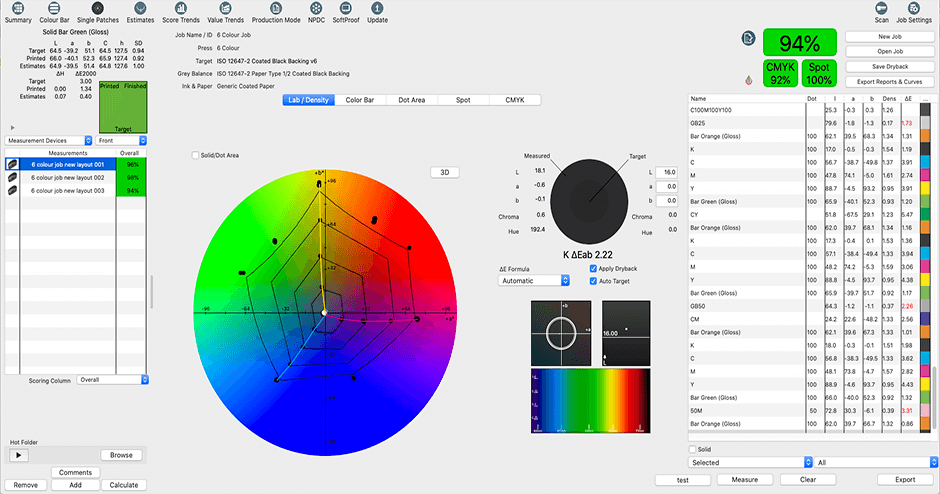
pressSIGN
pressSIGN V10 - New Features
- Support for ISO 12647-7 digital print targets
- Expanded colour gamut ICC profiles supported
- Automode for Epson proofers
- proofSIGN features included in pressSIGN
- Create new jobs remotely
- Auto re-synch to remote servers
- X-Rite iO Table now supported
- New export functions
- New file parser ManRoland ColorPilot
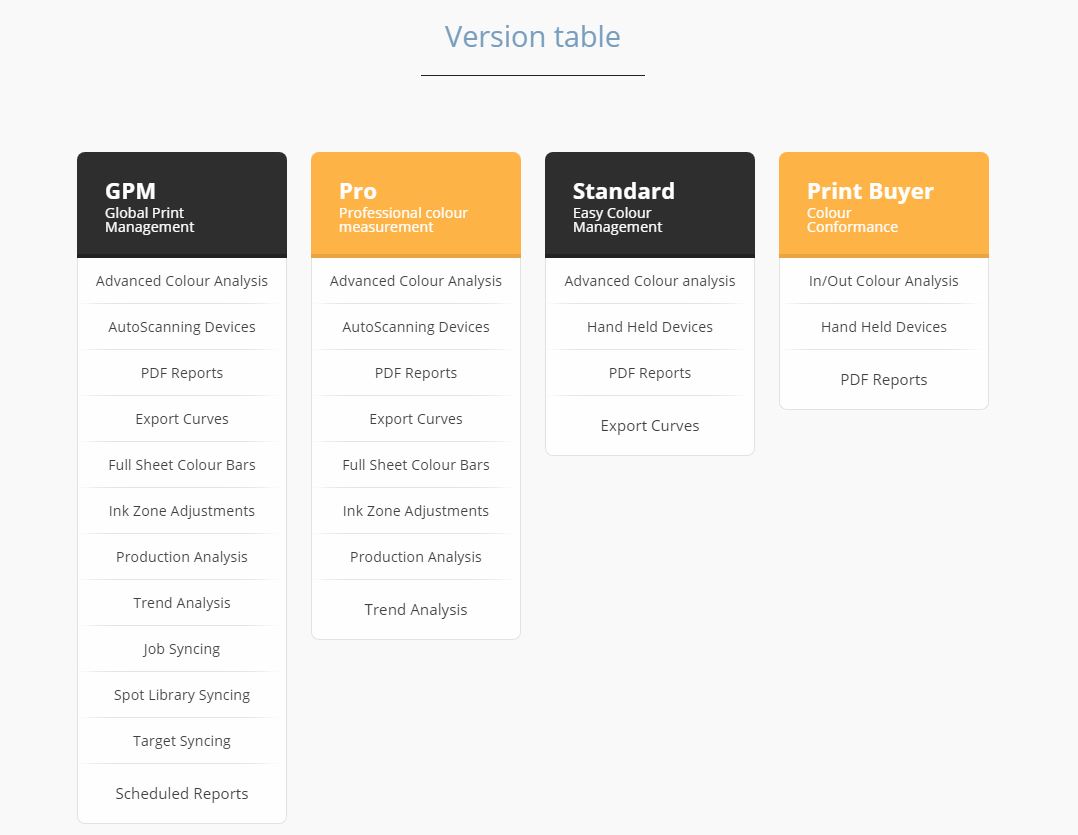
Each pressSIGN-Pro installation includes the pressSIGN-Pro server, pressSIGN-Pro client, a pressSIGN-Trends client and pressSIGN-Mobile client. Additional clients can be purchased.
Use pressSIGN’s soft proofing facility to visually check jobs in the production or pre-press office live from the press. Improve communication with the chat messaging service.
pressSIGN contains the PANTONE™ libraries and the ability to create custom colour libraries. Control not only solid spot colours but tints as well. Set spot tint targets based on previous prints or use pressSIGN’s Visual Linear Targeting (VLT) to achieve the smoothest possible blends.
Presssing-Pro V 10 main features
-
Features and
Benefits -
Score each
measurement -
Dynamic Density
adjustment -
Update substrate and
tonal curves - Print Targets
- Spot colours
- pressSIGN reports
- pressSIGN Clients
- Soft Proofing
- Connectivity
Main features
- Scores the measurement against the print target giving a colour coded overall score Print targets with tolerances and scoring are fully customisable. Score the spot colours, CMYK and overall.
- Dynamic Density Adjustment(DDA) uniquely predicts best possible density based on the selected print target and the actual paper, ink, chemistry in use for that job
- Dryback – accurately compensates for dry back for spot and process colours taking account of density variation
- Auto target adjustment for substrate – user doesn’t need to create a multitude of press targets for each substrate to get best quality of print.
- Creates and updates tonal curves using either TVI (dot gain), 4CX technology (grey balance) or Neutral Print Density.
- Print targets – all international standards supported, including all 7 ISO 15339 targets. Print targets fully customisable with automtaic white point compensation
- Spot Colours – includes PANTONE™ libraries for up to 16 colour printing, create custom spot libraries
- Spot Colour Tints – Control spot colour tints with pressSIGN’s Visual Linear Target (VLT) technology or use previously printed tints as your target.
- Dynamic Reports – get detailed reports on all aspects of production, compare operators, campaigns. Rank performance and follow trends all through a web browser interface
- Use any colour bar
- Ink substitution allows the same colour bar to be used whether spot or process colours
- Trend analysis reports showing press, operator, shift performance and wastage of print process for single or multiple jobs
- Monitor performance from the production office for all presses and printing devices
- Soft Proof at the press or in the production office, see the impact of paper colour and the actual press measurements on the job
- Check consistency across the press and against the OK sheet
- Connects to all scanning spectrophotometers and many third-party closed loop systems
- Templates reduce set up time
- Automode with templates automatically creates jobs from SVF files with no operator intervention
Each measurement is scored
Every measurement is given a score and colour coded to make it easy to decide how well the sheet was printed. The sheet is given an overall score which is further broken down into different measurement criteria. Finally the production report gives a score for all the measurements in the job.
The job criteria measured and scored are
- Primary colours
- Spot colours
- TVI
- Grey Balance
- Overprints – Lab and Trapping
- Sheet consistency
- Consistency against an OK or accepted sheet
- Paper colour
pressSIGN uses ISO 12647-2 tolerances by default, but all tolerances and scoring criteria can be fully customized by the user. The print target can be allocated globally across the enterprise or assigned to specific sites depending on the needs of the enterprise.

DDA
pressSIGN’s Dynamic Density Adjustment ensures that the operator is always name=achieving the closest colour match to the press target whatever the ink, paper or press environment. On each new job pressSIGN recalculates the correct density adjustment based on the current conditions. In fact, pressSIGN only needs to read one patch to know how to adjust the density.
The pressSIGN-Pro client shows the operator how to adjust each ink key across the press. The operator is targeting 0% adjustment, which means that if the ink level is either increased or decreased then the Delta E will rise. Instead of trying to hit an arbitrary density target the operator is achieving the best possible colour match to the press target.
Optionally ink zones can be turned off as part of the measurement and scoring functions when, for example, there is no significant coverage. DDA works with both process and spot colours.
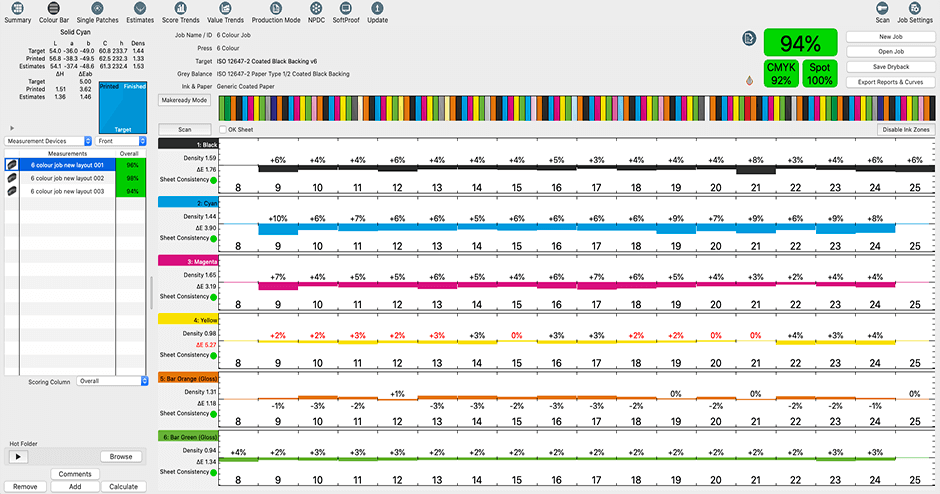
Auto Substrate adjustment
Printers who are asked to print to international printing standards like ISO 12647-2 or name=GRACol will often be asked to produce work on paper stocks that deviate from the standard. pressSIGN 6 gives print buyers and printers the option of allowing pressSIGN to automatically amend the print target based on the substrate’s white point.
Changing the white point target in response to paper color gives a better visual representation of the original.
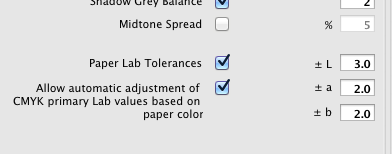
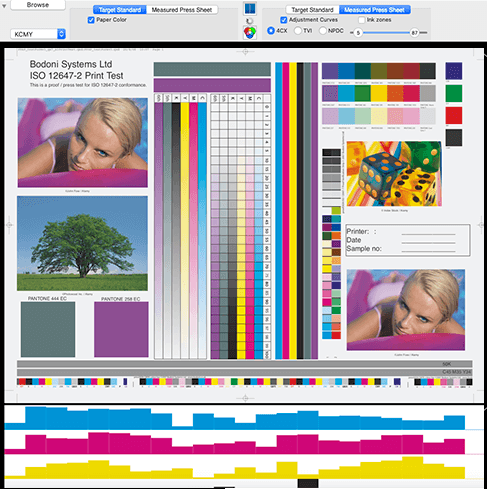
Set and update tonal curves
pressSIGN offers three methods of creating tonal curve adjustments, Tonal Value Increase (TVI), 4CX or Neutral Print Density. By measuring the colour bar containing a name=minimum of three tonal patches per colour (e.g. 25%, 50% and 75%) pressSIGN creates tonal adjustment curves and exports these curves to a whole variety of RIP formats for platesetters and digital devices.
Alternatively output the tonal curves to Autocurves and apply the adjustments to a PDF workflow. AutoCurves is an additional application that is useful in a digital environment or where a platesetter RIP is unable to update an existing curve.
TVI, usually deferred to as dot gain, is the traditional way that printers have matched international standards such as ISO 12647-2. It is a simple method of achieving colour matching to the standard.
4CX (4 Colour Exchange) technology targets grey balance for the tonal adjustments. 4CX takes into account black and white points of the target and print to produce the best visual match. For more details on 4CX technology visit the dedicated web page. pressSIGN 6 additional adds NPDC adjustments as a further means of attaining grey balance. NPDC reports maximum and average Delta L and F for CMY and maximum and average Delta L for black
When all conditions including ink and paper are ideal on a sheet fed offset press then 4CX, NPDC and TVI adjustments will produce the same results. However, we recommend 4CX on non-offset devices and where ink and paper do not precisely match the ISO standards.
Print Targets
pressSIGN supports all international print standards:-
- ISO 12647-2 (2007 and 2013)
- ISO 12647-3
- ISO 12647-4
- ISO 12647-6
- ISO 15339 (GRACol 2013)
- GRACol 2006
- Japan Color
Create customized print standards based on CMYK ICC profiles. pressSIGN also allows you to select a profile for the print condition and a separate profile for the grey balance. For example, the customer might require a job to be printed on uncoated paper but have supplied the file with a coated profile like ISOCoatedv2.icc. The ability to set a different target for the grey balance to the print condition allows you to generate correction curves that produce the best possible visual match.
Utilising an ICC profile as the print target allows pressSIGN to adjust the print target according to the colour of the substrate. Printing to the amended target will produce a better visual match to the proof. Export the amended ICC profile to pre-press for proofing or soft proofing.
Create a print standard based on a single or set of previously measured printed sheets. It is useful to capture the existing print set up so that it can be replicated for re-runs.
Spot Colours
To ensure brand consistency spot color printing is essential. pressSIGN-Pro can measure and control from one to 16 colors. The spot colors can be selected from either the PANTONE™ libraries or customer created libraries. Custom color libraries can be exported to other users.
The PANTONE™ spot colour libraries are included within pressSIGN. Select any PANTONE™ colour and pressSIGN will show the operator how to adjust the density to achieve the best possible match on the substrate.
Where spot colours exist in a job then pressSIGN provides a separate spot colour score for each measurement and the job.
Create custom spot colour libraries by measuring the colours, importing colour data files like CxF, or type in Lab values.
Compare any measurement with the nearest colour from the spot colour libraries.
Why rely on a visual judgements from a faded book when all can benefit from centrally controlled spectral data.
Set and update tonal curves
pressSIGN offers three methods of creating tonal curve adjustments, Tonal Value Increase (TVI), 4CX or Neutral Print Density. By measuring the colour bar containing a name=minimum of three tonal patches per colour (e.g. 25%, 50% and 75%) pressSIGN creates tonal adjustment curves and exports these curves to a whole variety of RIP formats for platesetters and digital devices.
Alternatively output the tonal curves to Autocurves and apply the adjustments to a PDF workflow. AutoCurves is an additional application that is useful in a digital environment or where a platesetter RIP is unable to update an existing curve.
TVI, usually deferred to as dot gain, is the traditional way that printers have matched international standards such as ISO 12647-2. It is a simple method of achieving colour matching to the standard.
4CX (4 Colour Exchange) technology targets grey balance for the tonal adjustments. 4CX takes into account black and white points of the target and print to produce the best visual match. For more details on 4CX technology visit the dedicated web page. pressSIGN 6 additional adds NPDC adjustments as a further means of attaining grey balance. NPDC reports maximum and average Delta L and F for CMY and maximum and average Delta L for black
When all conditions including ink and paper are ideal on a sheet fed offset press then 4CX, NPDC and TVI adjustments will produce the same results. However, we recommend 4CX on non-offset devices and where ink and paper do not precisely match the ISO standards.
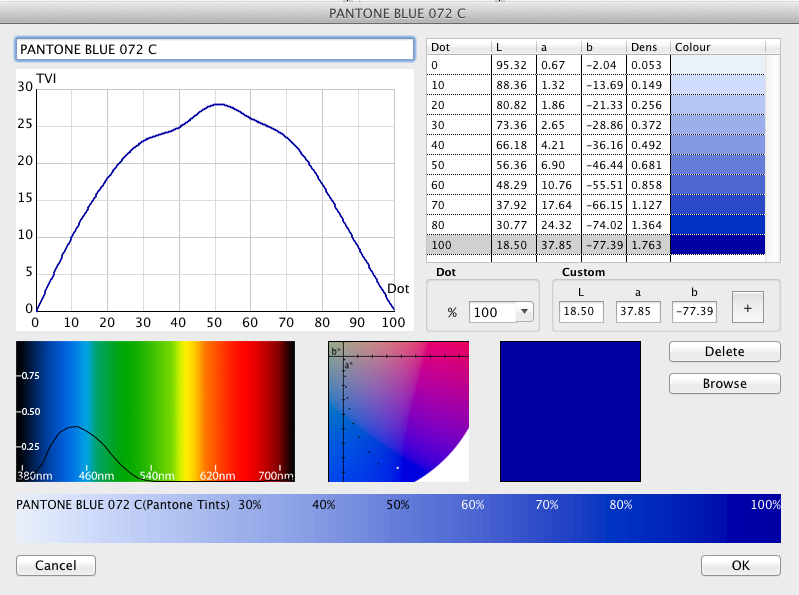
Any Colour Bar
Create any colour bar in pressSIGN’s colour bar generator and pressSIGN will score the reading against the target you have set.
Import CGATs or CxF data files and make these the print target files. pressSIGN 6 gives the user huge flexibility to determine what will be measured. For example, make the target bar a single colour with multiple tint patches to see how the printing device is producing a tonal curve for that colour. Check on the across the sheet consistency of a digital printer.
Create or import multi-line color bars such as the GRACol P2P target or FOGRA/UGRA Media wedge or simply copy an existing color bar including slurs marks.
pressSIGN Reports
pressSIGN-Pro offers the production manager much better understanding about the performance of the printing devices and the operators under his control through pressSIGN’s production reports. See which operators take longest to get to production. pressSIGN-Pro provides production managers with detailed analysis reports for individual jobs and across multiple jobs. Compare the performance of
- presses
- digital printing devices
- operators
- shifts
- consumables and paper
- category or sub-category
Produce a certification report for clients to demonstrate the quality of print.
pressSIGN-Pro also produces measurement report and a scoring report to give production manager’s a quick overview of any particular job.
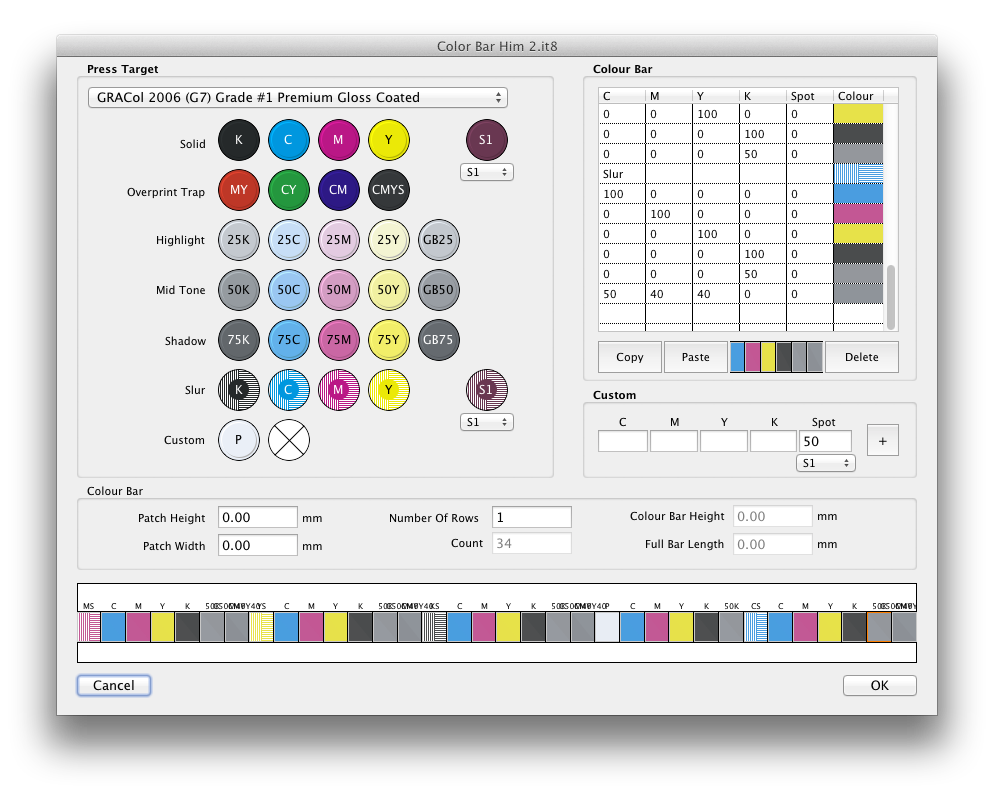

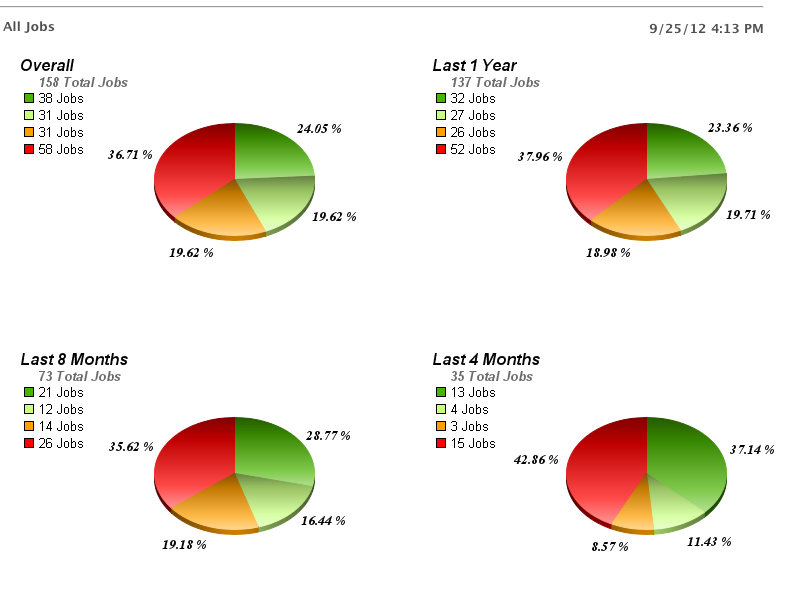
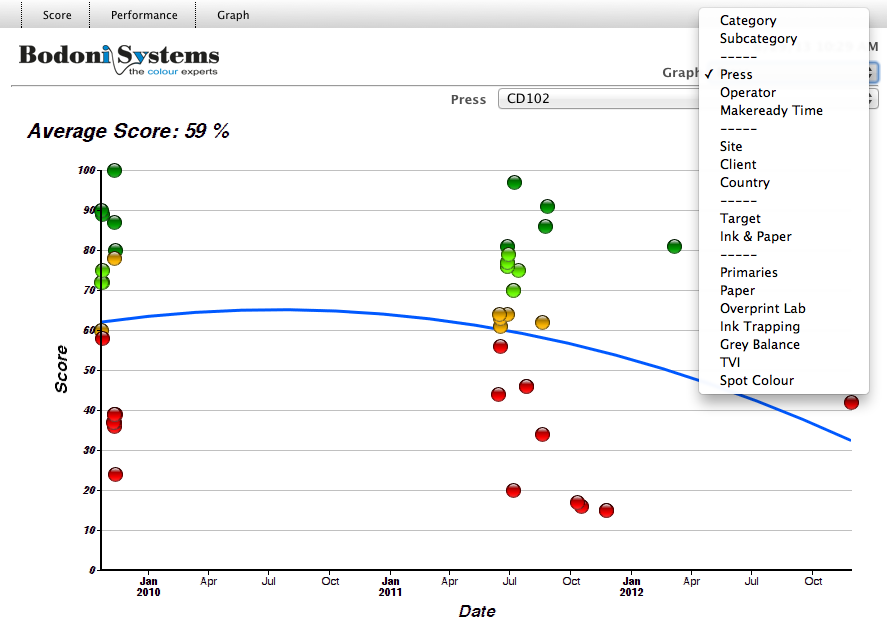
Dynamic Reports
Create dynamic reports showing trends, comparisons and ranking. Select all the data from the server or sort by any criteria and generate reports.
pressSIGN web browser reports
Pie Charts Ranking with average score & number of jobs Diagram with trend
Analyse your data to find out who is printing best whether it is by press, operator, print site or shift. See which paper stock gives you the best results and dig into how your campaigns have printed and with which press, printer etc you need to concentrate your resources.
pressSIGN Clients
pressSIGN 6 is a SQL Server based product that allows multiple clients to input and monitor the data from the printing devices connected to it. As part of the basic configuration pressSIGN-Pro v 5 is shipped with three clients additional clients can be added as required.
the Pro client that is used by the operator to measure and control the print device
the Trends client for use in the production/pre-press office – to assign jobs to the operator, to update tonal curves, to analyse performance and communicate to customers and colleagues. Has the same functionality as the Pro client without the ability to read in new data.
the Mobile client for the production manager to monitor performance and communicate with the operator from anywhere connected to the internet
While the Pro client sits by the printing device in order to read and monitor individual printed sheets and show the operator how to make the necessary adjustments to the press, the Trends and Mobile clients allow pre-press and production managers to monitor the press performance without the need to be on the shop floor.
The pre-press manager can see all jobs that are currently printing from the office, new jobs can be created, targets created and jobs assigned to the right press and the right operator. When the operator signs into pressSIGN he only sees his own jobs. From the pre-press office, the manager can update tonal curves without the need to visit the factory floor or disturb the operator. All production reports and analysis can take place using the pressSIGN-Trends client.
Keep in touch with the performance of the operators and presses from anywhere connected to the internet with the pressSIGN-Mobile client. Send and receive chat messages directly with the operator.
Soft Proofing
Soft proofing is included free of charge with pressSIGN-Pro and pressSIGN GPM. All pressSIGN-Pro and Trends clients have the soft-proofing module built-in.
Use the soft proofing module even before printing has started. Open up the print job in pressSIGN and measure the actual paper colour. See the impact the underlying substrate is going to have when you print.
Use pressSIGN’s soft proof module at press side to compare the printed sheets with the target. Use the soft proof module in the production office to see how well the job is being printed. See the impact of updating the tonal curves on the printed sheet.
Check for all types of consistency
Consistency is vital for all quality conscious print buyers. Consistency between printed jobs, wherever they are printed, consistency throughout the job and consistency across the printed sheet are all vital in matching clients requirements. presSIGN-Pro tracks these issues on behalf of the quality control or brand manager. At the same time pressSIGN-Pro shows the operators how to achieve this consistency.

pressSIGN Connectivity
Use pressSIGN-Pro to control of all the following Spectrophotometers:-
- X-Rite Intellitrax S
- X-Rite EasyTrax
- X-Rite Eye-One Pro and Eye-One Pro2
- X-Rite 530
- X-Rite SpectroEye
- X-Rite eXact for patch and scanning mode
- Techkon SprectroDrive
- Techkon SpectroJet
- Techkon SpectroDens for patch and scanning mode
- Barbieri LFP
- Barbieri Swing
- Barbieri SpectroPad
- Konica Minolta FD-7
pressSIGN-Pro connects with several third party closed loop systems including but not limited to Digital Information’s InkZone Loop, PrintFlow’s DIPS Online, Rutherford’s AutoPilot.
pressSIGN Pro’s automode will automatically create a job from an SVF file without any operator intervention using pressSIGN’s templates.
pressSIGN-Pro will accept data from a variety of different press consoles like Heidelberg’s Image Control, or Komori’s PDC-SII.
See how pressSIGN-Pro can help you and your company improve print quality, meet clients expectations and lower costs. Download a demo of the latest version of the software today.
